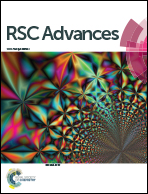Immobilization and molecular rearrangement of ionic liquids on the surface of carbon nanotubes
Abstract
Two imidazolium-based ionic liquids (ILs), i.e. [Bnmim][BF4] (1-benzyl-3-methylimidazolium tetrafluoroborate) and [Bmim][AuCl4] (1-butyl-3-methylimidazolium chloroauric acid), were adsorbed on the outer surface of multi-walled carbon nanotubes (MWCNTs) via a physical method. In order to understand the molecular packing of ILs immobilized on the MWCNTs surfaces, composite samples with different weight ratios of ILs were characterized by using X-ray photoelectron spectroscopy (XPS), differential scanning calorimetry (DSC), X-ray diffraction (XRD) and Fourier transform infrared spectroscopy (FT-IR). It was found that the rings of imidazolium cations of ILs are nearly parallel to the MWCNTs surfaces, and the packing orientation is determined by the substituent groups on the imidazolium-ring. Both the anions ([BF4]− and [AuCl4]−) occupy an adjacent area to the imidazolium cation to form a neutral surface layer. Furthermore, for the immobilized ILs, the melting point (Tm) of [Bmim][AuCl4] rises slightly, while the Tm of [Bnmim][BF4] gets depressed. The molecular rearrangement and the melting point change of the immobilized ILs result from the complex interfacial interactions between the ILs and the MWCNTs surfaces.


 Please wait while we load your content...
Please wait while we load your content...